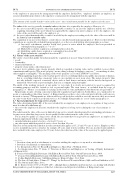Page 613 - SAIT Compendium 2016 Volume2
P. 613
IN 71 Income Tax acT: InTeRPReTaTIon noTes IN 71 to the employer or any person by arrangement with the employer. In this Note, ‘employer’ includes an employer, an
associated institution in relation to the employer or any person by arrangement with the employer.
The value of the asset is generally its market value at the time it is acquired by the employee. However, if –
(a) the asset is movable property (other than marketable securities or an asset the employer had the use of before acquiring ownership of the asset) which was acquired by the employer in order to dispose of it to the employee, the
value of the asset will be cost to the employer, or
(b) the asset (other than marketable securities) was held by the employer as trading stock, the value of the asset will be
the lower of cost or market value.
The acquisition of an asset at less than its’ actual value is a taxable bene t under paragraph 2 (a). However, the following acquisitions are speci cally excluded from paragraph 2 (a) as they are dealt with in other paragraphs or sections:
(i) Any meal, refreshment, voucher, board, fuel, power or water which the employee has been provided as contemplated in paragraph 2 (c)* or (d).†
(ii) Marketable securities acquired as contemplated in section 8A.
(iii) Qualifying equity shares acquired as contemplated in section 8B.‡
(iv) Equity instruments contemplated in section 8C.§
4.2 Nature of the asset awarded
The variety of assets that qualify for inclusion under the ‘acquisition of an asset’ fringe bene t is very wide and includes any – • goods;
• commodity;
• nancial instrument; or
• property of any nature (other than money).
An asset, in its ordinary sense, means property which is regarded as having value and is available to meet debts, commitments and legacies.¶ The word ‘property’ means a thing or things belonging to someone,** or something of value, either tangible or intangible.†† The meaning of the word ‘property’ is set out in LAWSA‡‡ as follows:
“When signifying a legal object, the word ‘property’ refers to everything which is susceptible of pecuniary evaluation, that is, everything which has a monetary value or can constitute an asset in an estate. The notion ‘property’ thus not only includes corporeal or material objects such as land, houses and motor vehicles but also incorporeal or immaterial objects such as personal rights, shares in a company and patent rights.”
The ambit of the wording ‘property of any nature’ is very wide. It is clearly not restricted to assets recognised for accounting purposes and also extends to real or personal rights. The term ‘money’ is excluded from the scope of paragraph 2 (a). ‘Money’ is a medium of exchange in the form of coins and banknotes that functions as legal tender.§§
Krugerrands, in spite of being coins and technically regarded as legal tender in South Africa, are considered to be goods or commodities rather than ‘money’. A Krugerrand does not have a face value and practically the gold coins are not used as ‘money’.¶¶ Krugerrands are either traded as goods by dealers or held as assets by investors; they are not used on a day-to-day basis to pay for goods and services. Accordingly, Krugerrands are ‘assets’ under paragraph 2 (a).
4.3 Special adjustment for long service awards
The value (determined under 4.1) of the asset awarded by an employer to an employee in recognition of long service, must be reduced by the lesser of –
• the cost to the employer of all assets awarded to the employee for long service during the year of assessment; or
• R5 000.
The reduction in the value of the asset is limited to long service awards. Awards granted for outstanding performance or for any reason other than long service do not qualify for this reduction in the value of the asset.
For an award to qualify as a long service award, the asset must have been given by an employer to an employee for being in employment with the same employer for–
• an initial unbroken period of service of at least 15 years; or
• any subsequent unbroken period of service of not less than 10 years.
This does not mean that the reduction in value automatically applies at 15, 25 and 35 years of service. Employees who receive an initial long service award at, for example, 20 years, must wait for a further 10 years, in other words until they have worked for the same employer for 30 years, before the reduction of the value of the asset may be applied again.
* Provision of any meal or refreshment or a voucher entitling the employee to any meal or refreshment.
† Provision of residential accommodation.
‡ See Interpretation Note 62 ‘Broad-Based Employee Share Plan’ (30 March 2011).
§ See Interpretation Note 55 (Issue 2) ‘Taxation of Directors and Employees on Vesting of Equity Instruments’
(30 March 2011).
¶ Concise Oxford English Dictionary.11th Edition Revised New York: Oxford University Press, 2006.
** Concise Oxford English Dictionary.11th Edition Revised New York: Oxford University Press, 2006
†† Collins English Dictionary. 3rd Edition Glasgow: Harper Collins, 1991. Print.
‡‡ The Law of South Africa, Volume 27: ‘Things’ by Professor CG van der Merwe, MyLexisNexis Publishers at 195. §§ The Oxford and Collins, above.
¶¶ S v Bennett-Cohen 1985 (2) SA 465 (ZS) – although this is a Zimbabwean Customs Act case dealing with whether
Krugerrands are goods for purposes of that Act, it discusses useful practical attributes of Krugerrand coins.
saIT comPendIum oF Tax LegIsLaTIon VoLume 2 605
The amount of the taxable bene t = value of the asset – any consideration payable by the employee for the asset.


